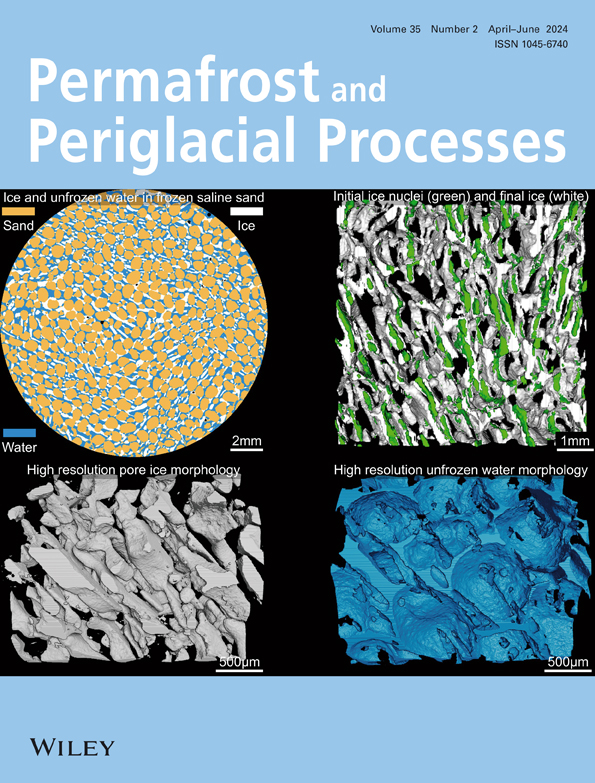斯瓦尔巴群岛湿地低中心和高中心冰楔多边形的生物地球化学特征
IF 3.3
3区 地球科学
Q2 GEOGRAPHY, PHYSICAL
引用次数: 0
摘要
北极湿地是全球重要的土壤有机碳储存库。它们通常以冰楔多边形为特征,这是低地永久冻土的诊断,并且在夏季对湿地水文和生物地球化学有很大影响。冰楔多边形的退化可能是对气候变化或局部扰动的响应,对生物地球化学过程的影响知之甚少。因此,我们使用来自活动层和顶部永久冻土的地球化学分析来识别和比较位于中斯瓦尔巴群岛的凸起海滩沉积物和山谷填充沉积物中的高中心(退化)和低中心(原始)多边形的主要生物地球化学过程。我们在两种情况下都发现了相似的富有机质沉积物(高达38%干wt.%),但低中心多边形是水饱和的,而高中心多边形则有相对干燥的活动力层。因此,低中心多边形显示铁和硫酸盐还原的证据,导致黄铁矿和菱铁矿的沉淀,而高中心多边形显示更多的氧化条件,铁氧化减少,铁和硫酸盐还原产物在沉积物中保存较少。因此,这项研究证明了冰楔多边形降解对宿主沉积物和孔隙水的氧化还原化学的深远影响,即更多的氧化条件,铁的还原减少,铁和硫酸盐还原产物的保存减少。本文章由计算机程序翻译,如有差异,请以英文原文为准。
Biogeochemistry of low‐ and high‐centered ice‐wedge polygons in wetlands in Svalbard
Arctic wetlands are a globally significant store of soil organic carbon. They are often characterized by ice‐wedge polygons, which are diagnostic of lowland permafrost, and which greatly influence wetland hydrology and biogeochemistry during summer. The degradation of ice‐wedge polygons, which can occur in response to climate change or local disturbance, has poorly understood consequences for biogeochemical processes. We therefore used geochemical analyses from the active layer and top permafrost to identify and compare the dominant biogeochemical processes in high‐centered (degraded) and low‐centered (pristine) polygons situated in the raised beach sediments and valley‐infill sediments of Adventdalen, Central Svalbard. We found similar organic‐rich sediments in both cases (up to 38 dry wt.%), but while low‐centered polygons were water‐saturated, their high‐centered counterparts had a relatively dry active layer. Consequently, low‐centered polygons showed evidence of iron and sulfate reduction leading to the precipitation of pyrite and siderite, whilst the high‐centered polygons demonstrated more oxidizing conditions, with decreased iron oxidation and low preservation of iron and sulfate reduction products in the sediments. This study thus demonstrates the profound effect of ice‐wedge polygon degradation on the redox chemistry of the host sediment and porewater, namely more oxidizing conditions, a decrease in iron reduction, and a decrease in the preservation of iron and sulfate reduction products.
求助全文
通过发布文献求助,成功后即可免费获取论文全文。
去求助
来源期刊
CiteScore
9.70
自引率
8.00%
发文量
43
审稿时长
>12 weeks
期刊介绍:
Permafrost and Periglacial Processes is an international journal dedicated to the rapid publication of scientific and technical papers concerned with earth surface cryogenic processes, landforms and sediments present in a variety of (Sub) Arctic, Antarctic and High Mountain environments. It provides an efficient vehicle of communication amongst those with an interest in the cold, non-glacial geosciences. The focus is on (1) original research based on geomorphological, hydrological, sedimentological, geotechnical and engineering aspects of these areas and (2) original research carried out upon relict features where the objective has been to reconstruct the nature of the processes and/or palaeoenvironments which gave rise to these features, as opposed to purely stratigraphical considerations. The journal also publishes short communications, reviews, discussions and book reviews. The high scientific standard, interdisciplinary character and worldwide representation of PPP are maintained by regional editorial support and a rigorous refereeing system.

 求助内容:
求助内容: 应助结果提醒方式:
应助结果提醒方式:


